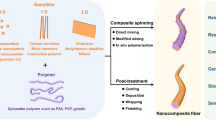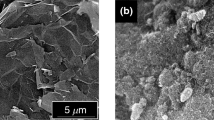Abstract
Hybrid Polytetrafluoroethylene / ultrafine-glass-fiber (PTFE/UGF) composites were fabricated via a cold pressing and sintering method. The UGF were modified with coupling agent (3-aminopropyl) triethoxysilane (APTES) with different concentrations of 0%, 5%, 10% and 15%, respectively. Various thermal properties, including thermal conductivity, crystallization behavior, thermal decomposition temperature, coefficient of thermal expansion, high-temperature compressive creep behavior were investigated based on the composite morphology. Due to the substantially different properties between the inorganic particles and polymer matrix, the thermal conductivity and the thermal resistance index were increased, while the thermal expansion coefficient and high-temperature compressive creep strain of composites were decreased upon the addition of the UGF. Meanwhile, the thermal properties of the composites filled with surface treated ultrafine-fibers were significantly improved compared to the untreated composites. The thermal conductivity and thermal resistance index of PTFE hybrid composite with 15 wt% t-UGF content increased by 67.46% and 2.17% respectively, and the thermal expansion coefficient and high-temperature compressive creep strain decreased by 85.03% and 89.64% respectively in comparison with neat PTFE. These improvements were attributed to the surface treatment which could effectively enhance the interfacial compatibility between the UGF and the PTFE matrix, reducing the internal defects and improving the crystallinity in the composites.












Similar content being viewed by others
References
Hu Y, Du G, Chen N (2016) A novel approach for Al2O3/epoxy composites with high strength and thermal conductivity. Compos Sci Technol 124:36–43
Lapčík L, Ruszala MJA, Vašina M, Lapčíková B, Vlček J, Rowson NA, Grover LM, Greenwood RW (2016) Hollow spheres as nanocomposite fillers for aerospace and automotive composite materials applications. Compos Part B-Eng 106:74–80
Chen J, Ren S, He X, Qu X (2017) Properties and microstructure of nickel-coated graphite flakes/copper composites fabricated by spark plasma sintering. Carbon 121:25–34
Wyszkowska E, Leśniak M, Kurpaska L, Prokopowicz R, Jozwik I, Sitarz M, Jagielski J (2018) Functional properties of poly(tetrafluoroethylene) (PTFE) gasket working in nuclear reactor conditions. J Mol Struct 1157:306–311
Chen Q, Chu G, Luo Y, Sang L, Zhang LL, Zou H, Chen J (2016) Polytetrafluoroethylene wire mesh packing in a rotating packed bed: mass-transfer studies. Ind Eng Chem Res 55:11606–11613
Qi Y, Luo Q, Shen J, Zheng L, Zhou J, Chen W (2017) Surface modification of BMN particles with silane coupling agent for composites with PTFE. Appl Surf Sci 414:147–152
Li Y, Wang Z, Jiang C, Niu H (2017) Experimental study on impact-induced reaction characteristics of PTFE/Ti composites enhanced by W Particles. Materials 10:175
Glavier L, Taton G, Ducéré J, Baijot V, Pinon S, Calais T, Estève A, Djafari Rouhani M, Rossi C (2015) Nanoenergetics as pressure generator for nontoxic impact primers: comparison of Al/Bi2O3, Al/CuO, Al/MoO3 nanothermites and Al/PTFE. Combust Flame 162:1813–1820
Luo W, Liu Q, Li Y, Zhou S, Zou H, Liang M (2016) Enhanced mechanical and tribological properties in polyphenylene sulfide/polytetrafluoroethylene composites reinforced by short carbon fiber. Compos Part B-Eng 91:579–588
Peng H, Ren H, Dang M, Zhang Y, Yao X, Lin H (2018) Novel high dielectric constant and low loss PTFE/CNT composites. Ceram Int 44:16556–16560
Jin Z, Chen X, Wang Y, Wang D (2015) Thermal conductivity of PTFE composites filled with graphite particles and carbon fibers. Comput Mater Sci 102:45–50
Zhan YL, Ruan M, Li W, Li H, Hu LY, Ma FM, Yu ZL, Feng W (2017) Fabrication of anisotropic PTFE superhydrophobic surfaces using laser microprocessing and their self-cleaning and anti-icing behavior. Colloid Surface A 535:8–15
Bi C, Zhang H, Xiao S, Zhang Y, Mai Z, Li X (2011) Grafted porous PTFE/partially fluorinated sulfonated poly(arylene ether ketone) composite membrane for PEMFC applications. J Membr Sci 376:170–178
Zhang D, Kou K, Gao P, Zhang Y, Zheng Z (2014) Effects of uniaxial drawing on the performance and structure of filled polytetrafluoroethylene. Polym Eng Sci 54:1427–1435
Lu Y, Li X, Wu C, Xu S (2018) Comparison between polyether titanate and commercial coupling agents on the properties of calcium sulfate whisker/poly(vinyl chloride) composites. J Alloys Compd 750:197–205
Huang C, Huang Z, Lv X, Zhang G, Wang Q, Wang B (2017) Surface modification of hollow glass microsphere with different coupling agents for potential applications in phenolic syntactic foams. J Appl Polym Sci 134
Zhang Q, Gao F, Zhang C, Wang L, Wang M, Qin M, Hu G, Kong J (2016) Enhanced dielectric tunability of Ba0.6Sr0.4TiO3/poly(vinylidene fluoride) composites via interface modification by silane coupling agent. Compos Sci Technol 129:93–100
Pickering KL, Raa Khimi S, Ilanko S (2015) The effect of silane coupling agent on iron sand for use in magnetorheological elastomers part 1: surface chemical modification and characterization. Compos Part A-Appl S 68:377–386
Min Y, Fang Y, Huang X, Zhu Y, Li W, Yuan J, Tan L, Wang S, Wu Z (2015) Surface modification of basalt with silane coupling agent on asphalt mixture moisture damage. Appl Surf Sci 346:497–502
Zhao M, Ren Z, Yang M, Yang W (2019) Effects of modified nano-silica on the microstructure of PVDF and its microporous membranes. J Polym Res 26:28
Rojo E, Alonso MV, Oliet M, Del Saz-Orozco B, Rodriguez F (2015) Effect of fiber loading on the properties of treated cellulose fiber-reinforced phenolic composites. Compos Part B-Eng 68:185–192
Pathak AK, Garg H, Singh M, Yokozeki T, Dhakate SR (2019) Enhanced interfacial properties of graphene oxide incorporated carbon fiber reinforced epoxy nanocomposite: a systematic thermal properties investigation. J Polym Res 26:23
Wang X, Wang L, Lian W, Zhou A, Cao X, Hu Q (2018) The influence of carbon spheres on thermal and mechanical properties of epoxy composites. J Polym Res 25:223
Jia Z, Gao Z, Lan D, Cheng Y, Wu G, Wu H (2018) Effects of filler loading and surface modification on electrical and thermal properties of epoxy/montmorillonite composite. Chinese Phys B 27:117806
Wang Z, Yang M, Cheng Y, Liu J, Xiao B, Chen S, Huang J, Xie Q, Wu G, Wu H (2019) Dielectric properties and thermal conductivity of epoxy composites using quantum-sized silver decorated core/shell structured alumina/polydopamine. Compos Part A-Appl S 118:302–311
Pan C, Kou K, Jia Q, Zhang Y, Wu G, Ji T (2017) Improved thermal conductivity and dielectric properties of hBN/PTFE composites via surface treatment by silane coupling agent. Compos Part B-Eng 111:83–90
Pan C, Kou K, Zhang Y, Li Z, Wu G (2018) Enhanced through-plane thermal conductivity of PTFE composites with hybrid fillers of hexagonal boron nitride platelets and aluminum nitride particles. Compos Part B-Eng 153:1–8
Pan C, Kou K, Zhang Y, Li Z, Ji T, Wu G (2018) Investigation of the dielectric and thermal conductive properties of core–shell structured HGM@hBN/PTFE composites. Mater Sci Eng B-Adv 238-239:61–70
Han H, Li HQ, Liu M, Xu L, Xu J, Wang S, Ni H, Wang Z (2017) Effect of “bridge” on the performance of organic-inorganic crosslinked hybrid proton exchange membranes via KH550. J Power Sources 340:126–138
Wei B, Chang Q, Bao C, Dai L, Zhang G, Wu F (2013) Surface modification of filter medium particles with silane coupling agent KH550. Colloid Surface A 434:276–280
Chen Q, Yakovlev NL (2010) Adsorption and interaction of organosilanes on TiO2 nanoparticles. Appl Surf Sci 257:1395–1400
Valadez-Gonzalez A, Cervantes-Uc JM, Olayo R, Herrera-Franco PJ (1999) Chemical modification of henequén fibers with an organosilane coupling agent. Compos Part B-Eng 30:321–331
Mallakpour S, Motirasoul F (2017) Preparation of PVA/α-MnO2-KH550 nanocomposite films and study of their morphology, thermal, mechanical and Pb(II) adsorption properties. Prog Org Coat 103:135–142
Wu H, Li Y, Tang X, Hussain G, Zhao H, Li Q, Adedotun A (2015) Nano-mechanical characterization of plasma surface tungstenized layer by depth-sensing nano-indentation measurement. Appl Surf Sci 324:160–167
Shirazi RN, Rochev Y, Mchugh P (2016) Nanoindentation of solvent-cast and compression-moulded poly(lactic-co-glycolic acid) to determine elastic modulus and hardness. Polym Test 50:111–118
Díez-Pascual AM, Gómez-Fatou MA, Ania F, Flores A (2015) Nanoindentation in polymer nanocomposites. Prog Mater Sci 67:1–94
Huang C, Qian X, Yang R (2018) Thermal conductivity of polymers and polymer nanocomposites. Mater Sci Eng R 132:1–22
Ding P, Zhuang N, Cui X, Shi L, Song N, Tang S (2015) Enhanced thermal conductive property of polyamide composites by low mass fraction of covalently grafted graphene nanoribbons. J Mater Chem C 3:10990–10997
Shen S, Henry A, Tong J, Zheng R, Chen G (2010) Polyethylene nanofibres with very high thermal conductivities. Nat Nanotechnol 5:251–255
Peng X, Li K, Mi H, Jing X, Chen B (2016) Excellent properties and extrusion foaming behavior of PPC/PS/PTFE composites with an in situ fibrillated PTFE nanofibrillar network. RSC Adv 6:3176–3185
Abdou JP, Reynolds KJ, Pfau MR, van Staden J, Braggin GA, Tajaddod N, Minus M, Reguero V, Vilatela JJ, Zhang S (2016) Interfacial crystallization of isotactic polypropylene surrounding macroscopic carbon nanotube and graphene fibers. Polymer 91:136–145
Jiang Z, Guo Z, Pu C, Jia Z, Xiao C, Jin J (2017) Effect of coupling agent on crystallization and rheological properties of poly(ethylene terephthalate) composite masterbatches. Polym Compos 38:2358–2367
Wang L, Wang Y, Huang Z, Weng Y (2015) Heat resistance, crystallization behavior, and mechanical properties of polylactide/nucleating agent composites. Mater Des 66:7–15
Wang J, Yang J, Deng L, Fang H, Zhang Y, Wang Z (2015) More dominant shear flow effect assisted by added carbon nanotubes on crystallization kinetics of isotactic polypropylene in nanocomposites. ACS Appl Mater Interfaces 7:1364–1375
Shi Y, Chen F, Yang J, Zhong M (2010) Crystallinity and thermal stability of LDH/polypropylene nanocomposites. Appl Clay Sci 50:87–91
Liang JZ, Li B, Ruan JQ (2015) Crystallization properties and thermal stability of polypropylene composites filled with wollastonite. Polym Test 42:185–191
Muratov DS, Kuznetsov DV, Il Inykh IA, Mazov IN, Stepashkin AA, Tcherdyntsev VV (2014) Thermal conductivity of polypropylene filled with inorganic particles. J Alloys Compd 586:S451–S454
Pan C, Kou K, Wu G, Zhang Y, Wang Y (2016) Fabrication and characterization of AlN/PTFE composites with low dielectric constant and high thermal stability for electronic packaging. J Mater Sci-Mater El 27:286–292
Gu J, Liang C, Zhao X, Gan B, Qiu H, Guo Y, Yang X, Zhang Q, Wang D (2017) Highly thermally conductive flame-retardant epoxy nanocomposites with reduced ignitability and excellent electrical conductivities. Compos Sci Technol 139:83–89
Wang Z, Qi R, Wang J, Qi S (2015) Thermal conductivity improvement of epoxy composite filled with expanded graphite. Ceram Int 41:13541–13546
Yu J, Huang X, Wu C, Wu X, Wang G, Jiang P (2012) Interfacial modification of boron nitride nanoplatelets for epoxy composites with improved thermal properties. Polymer 53:471–480
Acknowledgments
This work was financially supported by Natural Science Basic Research Plan in Shaanxi Province of China (Nos. 2014JQ6199, 2015JM5215).
Author information
Authors and Affiliations
Corresponding author
Additional information
Publisher’s note
Springer Nature remains neutral with regard to jurisdictional claims in published maps and institutional affiliations.
Rights and permissions
About this article
Cite this article
Zhang, Y., Kou, K., Zhang, S. et al. Improving thermal properties of ultrafine-glass-fiber reinforced PTFE hybrid composite via surface modification by (3-aminopropyl)triethoxysilane. J Polym Res 26, 214 (2019). https://doi.org/10.1007/s10965-019-1886-2
Received:
Accepted:
Published:
DOI: https://doi.org/10.1007/s10965-019-1886-2




